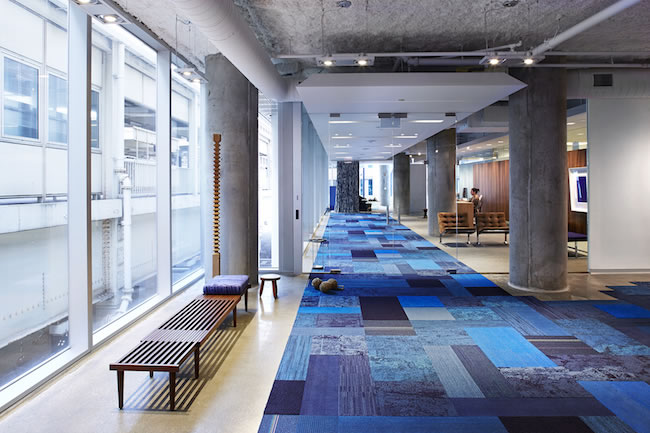According to the United Nations’ 2014 revision of the World Urbanization Prospects report, the number of people living in urban areas has reached 54%. And though the seemingly sudden, epoch-making reality of urban populations representing more than half of the world’s whole has invited a host of socio-environmental projections, the volume of certain hypotheses has tended to drown out others. For instance, with urbanization on the upswing, human detachment from fundamental components of nature has traced it. Based on key findings from a recent study commissioned by Interface, the world’s biggest designer and producer of carpet tile, this trend is advancing to the detriment of our workplace stability and productivity. And though the concept of “biophilia” still might be a relatively esoteric one, the carpet brand’s Human Spaces Global Report indicates that it is an idea well worth our collective embrace, deserved of the adoption of the design and architecture communities.
Led by award-winning psychologist Sir Cary Cooper, the study surveyed thousands of office workers from 16 different countries. The results point to consistencies in benefits of nature-integrated (or –simulated) office environments contrasted with workplaces devoid of such. The crucial takeaway from the study was that, in workplaces that had palpable connections to the natural world, Cooper’s team found a 6% employee productivity increase, a 15% spike in overall creativity, and a 15% greater sense of well being. “Concepts like biophilia are at the core of Interface’s sustainability journey,” insists Nadine Gudz, director of sustainability strategy at Interface. “Biophilia is the biological need that humans have to connect with the natural world.” But an industrial division between human beings and their natural environs has interrupted this harmony, explains Gudz.
Indeed, human subjection to nature as a necessity might seem initially like an obvious biological given. However, significant findings in the study reveal that considerable portions of our lives are spent deprived of such basic organic essentials. According to the Human Spaces Global Report, 64% of offices in the US aren’t penetrated by natural light while 70% are devoid of decorative plants and greenery (globally, the figures are 47% and 58%, respectively). Nearly a third of Canadian workers reported not having windows. “The average office worker in the United States currently toils in a windowless, largely sensory deprived environment devoid of forms and features of the natural environment,” inserts Stephen Kellert, Tweedy Ordway Professor Emeritus of Social Ecology and Senior Research Scholar at the Yale University School of Forestry and Environmental Studies. Kellert is a leading thinker in the emerging field of biophilia and has even produced a documentary on the subject, entitled Biophilic Design: The Architecture of Life. He invokes additional studies that show nature-deficient spaces resulting in “boredom, fatigue, illness symptoms, and absenteeism”—hardly the kind of sensibilities an employer would deem sustainable, much less ideal.
And though urban industrialization has proven to effectively thwart the relationship between human beings and Mother Nature, our instincts appear to be signaling to us what it is we’re missing. A third of those surveyed stated explicitly that workplace design that integrated contact with nature would inf luence their decision to work for a company. “It was evident to Interface that our customers were evolving in their understanding of sustainability and green building,” says David Gerson, senior director of Americas marketing and global activation. “Our clients were becoming increasingly concerned about indoor environmental quality and employee well being.” It’s a revelation that has spurred action across the globe, Gerson has observed, noting, “In some parts of Scandinavia, it is the law that every employee has access to daylight and views.” In theory, large-scale application of this model could lead to economic gains. “The fact is,” Gerson says, “if we think about incorporating biophilic design up front, workers will be more productive, more creative and ultimately, have a higher sense of well-being.”
Biophilic design is not a one-size- fits-all panacea, however. The study did reveal that measurable cultural differences are present in preferences concerning how a given country will choose to pursue biophilic design on its own volition. Varying tastes notwithstanding, though, the concept itself is universal and is gradually, however incrementally, being accepted and advanced.
Kellert has taken notice. “There appears to be growing recognition of the need to create more nurturing and satisfying built environments consistent with people’s inherent need to affiliate with natural systems and processes,” he affirms. And Interface seems to be enthused in positioning themselves as first among the aforementioned creators. Gudz expounds, “I am excited about the potential for Human Spaces and biophilic design to help deepen our conversations about our connection with nature. Biophilic design has the potential to help take conversations and practice beyond ‘green’ and deepen the connection between health and well-being with sustainable design.”

